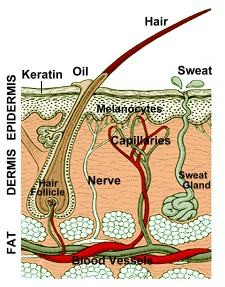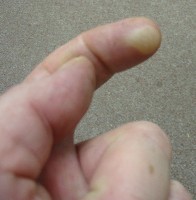

Let's look at skin and what's under it.
Skin is made up of two layers:
- The epidermis is the outer layer. There are various kinds of epidermal cells. Keratin is the outer thin layer of skin cells, which are continually dying and flaking off, to be replaced by new cells from below. Melanocytes are cells which produce colour to protect you from UV rays. There are also sensory receptor cells that provide information about touch and other senses.
The epidermis itself has four layers, except on your palms and the soles of your feet, where there are five; the extra outer layer of skin cells there provides added protection.
- The dermis is the next layer down, and it's is full of nerves, blood vessels, hair follicles, oil and sweat glands. The lower level of the dermis contains connective tissue made from interlacing collagen fibers, providing strength.
Below all this is a layer of fat.
 After an unfortunate incident with a hot muffler on a lawnmower, I discovered (quite quickly) that I had a nasty burn on my finger. After several minutes of intense pain, and the uttering of a few words that probably wouldn't be appropriate to repeat here, a large blister appeared on the burned area at the end of my finger. After a little prodding and poking, I realized that the blister was full of liquid. Where did this liquid come from, and why did the blister form in the first place? What purpose do blisters serve?
After an unfortunate incident with a hot muffler on a lawnmower, I discovered (quite quickly) that I had a nasty burn on my finger. After several minutes of intense pain, and the uttering of a few words that probably wouldn't be appropriate to repeat here, a large blister appeared on the burned area at the end of my finger. After a little prodding and poking, I realized that the blister was full of liquid. Where did this liquid come from, and why did the blister form in the first place? What purpose do blisters serve?
I wanted to know what was going on under my blistered skin, so I did some research, which I'll share here. Fortunately the blister wasn't on my typing finger !
When you get a burn, the severity of the injury is determined by how many layers get destroyed. Burns are classified as first, second and third degree, with each being progressively worse.
- First degree burns are superficial. They affect only the epidermis, and cause reddening and a little swelling. The red area will turn white when you press on it. The skin over these burns peels off after a few days, and the burned area is mostly healed after a week or so.

- Second degree burns are deeper, causing damage to the epidermis and partail damage to the dermis, including the blood vessels. They cause blisters, and are painful.
The fluid inside a blister is called serum. It's a watery liquid that leaks
from nearby tissues and blood vessels that have been destroyed. This blister filled with serum
provides pillow-like protection for the skin beneath it. Second degree burns take several weeks to heal completely. Eventually the fluid inside the blister is absorbed by the body, and the dead blister skin will drop away, leaving new skin underneath.
From a visitor to our site, Dan Pestana, we received futher information about serum:
"Serum is the liquid part of the blood, normally a golden yellow color, that is left when the blood cells are removed. It is comprised of water, as well as a very high content of various proteins. These include:
- albumin: a protein that aids in the proper retention of water in the bloodstream
- globulins: which are antibodies
- other useful proteins
Serum accumulates on burns, scrapes, or impetigo sores and as it dries, produces a characteristic honey-golden crust".
- Third degree burns are ones that cause extensive damage to the epidermis and dermis, destroying blood vessels, nerves and glands as well. The outer layer of keratin is gone, allowing moisture to escape; death from dehydration can follow extensive 3rd degree burns. If untreated, infection of the exposed under-layers can also result.
If enough blood vessels are damaged, blood clots will form, creating a scab. As the wound heals, remaining epidermis cells begin to produce new cells at a fast rate. Eventually the wound fills in, but if the wound is deep, there will be a scar. Scar is tissue composed of collagen fibers arranged to provide maximum strength. Because a scar does not contain nerves, it will feel numb. Complete healing can take a month or more.
Since severe third degree burns leave scars, they are often treated by applying skin grafts. A skin graft is a very thin layer of skin that is cut from an unburned area and put on the burned area.
Treating Burns
First Degree:
Soak the burn in cool water. Then treat it with aloe vera cream or an antibiotic ointment. To protect the burned area, put a dry gauze bandage over the burn.
Second Degree:
Soak the burn in cool water for 15 minutes. If the burned area is small, put cool, clean wet cloths on the burn for a few minutes every day. Then put on an antibiotic cream. Cover the burn with a nonstick dressing held in place with gauze or tape. Check the burn every day for signs of infection, such as increased pain, redness, swelling or pus. If you see any of these signs, go to your doctor right away. To prevent infection, don't break the blisters.
If a first or second degree burn covers a large area, or is on your face, hands, feet or genitals, you should see a doctor right away.
Ice or very cold water is no longer the recommended treatment for first or second degree burns, since it has been found that this will also cause damage to the tissues. Instead, cool running water applied to the burned area will ease pain and stop further damage to hot tissues.
Third Degree:
If you get a bad burn, you should see your doctor or go to the hospital right away. Don't take off any clothing that is stuck to the burn. Don't soak the burn in water.
A person with an electrical burn, even a small one, should go to the hospital right away. Electrical burns often cause serious injury inside the body. This injury may not show on the skin.
A chemical burn should be washed with large amounts of water. Remove any clothing that still has the chemical on it. Don't put anything on the burn area ... this could cause a chemical reaction that could make the burn worse. Then call your local poison control center or see your doctor right away.
Resources
|


 After an unfortunate incident with a hot muffler on a lawnmower, I discovered (quite quickly) that I had a nasty burn on my finger. After several minutes of intense pain, and the uttering of a few words that probably wouldn't be appropriate to repeat here, a large blister appeared on the burned area at the end of my finger. After a little prodding and poking, I realized that the blister was full of liquid. Where did this liquid come from, and why did the blister form in the first place? What purpose do blisters serve?
After an unfortunate incident with a hot muffler on a lawnmower, I discovered (quite quickly) that I had a nasty burn on my finger. After several minutes of intense pain, and the uttering of a few words that probably wouldn't be appropriate to repeat here, a large blister appeared on the burned area at the end of my finger. After a little prodding and poking, I realized that the blister was full of liquid. Where did this liquid come from, and why did the blister form in the first place? What purpose do blisters serve?